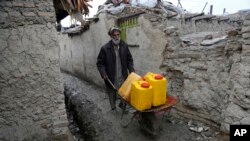The United Nations says the ongoing drought has gripped two-thirds of conflict-hit Afghanistan’s 34 provinces and has put more than 2 million people at risk of becoming severely food insecure.
Water points and fountains across the country have dried up, and the lack of rain and snow melt has caused rivers to run low or dry up completely, according to a weekly report by the U.N. Office for the Coordination of Humanitarian Affairs, OCHA.
The lack of water has prompted farmers to delay planting crops and reduce their field sizes in an effort to minimize losses. U.N. officials said in many cases there was nothing formers could do but watch the seeds dry out.
The humanitarian agency cautioned that the drought already has “negatively and irreversibly” affected the winter agricultural season of 2017/2018, and it also is expected to have a negative impact on the 2018 spring and summer agricultural season. It added that the last harvest must be considered completely lost.
The agency already has documented the first migration movements of more than 21,000 people since the beginning of May to urban centers due to drought and depleted food stocks of families.
"Some 1.5 million goats and sheep in the northeastern region are struggling to find food, and more than 600 out of nearly 1,000 villages in the province are suffering from the lack of water," OCHA said in a statement.
OCHA said humanitarian partners urgently need $115 million to respond to the needs of the 1.4 million most vulnerable people hit by the drought.
The agency said the intensified conflict across many parts of Afghanistan is exacerbating the effects of the drought and has limited the communities’ access to markets.
The Taliban insurgency, which controls or contests nearly, half of the Afghan territory, has intensified attacks across the country and overrun new districts.
Humanitarian workers cite security concerns due to active fighting in insurgent-controlled areas for a lack of access to communities in need in these areas.
A U.S. government oversight agency, the Special Inspector General for Afghanistan Reconstruction (SIGAR), in its latest quarterly report has noted that more than 11 million Afghans are living in areas that are contested or under control of Taliban-led armed groups.











